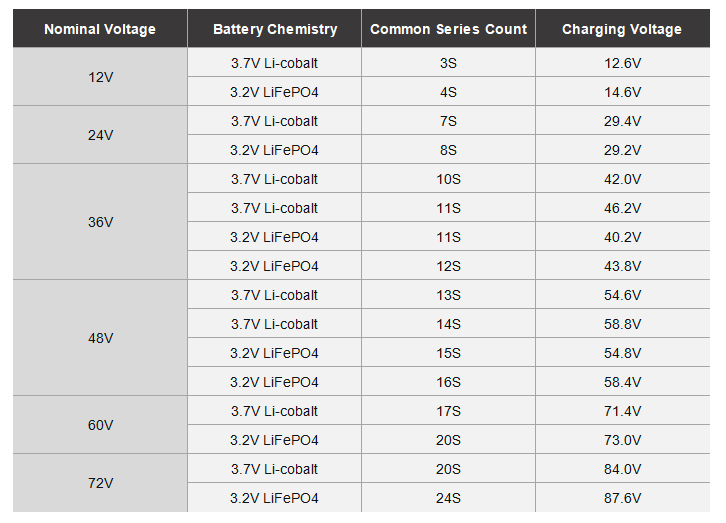A Complete Guide to Lithium Battery Series-Parallel Connections: Common Combinations, Pack Assembly, and Correct Practices
01 Definition of Lithium Battery Series-Parallel Connections
Due to the limited voltage and capacity of individual batteries, series-parallel connections are often required in practice to achieve higher voltages and capacities to meet the power requirements of the device.
Lithium battery series connection: Voltages are added, capacity remains constant, and internal resistance increases.
Lithium battery parallel connection: Voltage remains constant, capacity is added, internal resistance decreases, and power supply duration is extended.
Lithium battery series-parallel connection: Battery packs combine both parallel and series connections, increasing voltage and capacity.
Series voltage: 3.7V individual batteries can be assembled into battery packs with a voltage of 3.7*(N)V (N: number of individual batteries) as needed.
For example, 7.4V, 12V, 24V, 36V, 48V, 60V, 72V, etc.
Parallel Capacity: 2000mAh cells can be assembled into battery packs with a capacity of 2*(N)Ah (N: number of cells) as needed.
For example, 4000mAh, 6000mAh, 8000mAh, 5Ah, 10Ah, 20Ah, 30Ah, 50Ah, 100Ah, etc.
02 Lithium Battery Pack
Lithium battery packs refer to the processing, assembly, and packaging of lithium battery packs. The process of assembling lithium battery cells into groups is called a pack. This can be a single cell or a series-parallel lithium battery pack. A lithium battery pack typically consists of a plastic casing, protective board, battery cells, output electrodes, contact pads for connection, and other insulating tape and double-sided tape.
-
Lithium cell: The core component of the finished battery.
-
Protection board: Provides protection against overcharge, over-discharge, overcurrent, short circuit, and NTC temperature control.
-
Plastic casing: The supporting framework of the entire battery; it positions and secures the protective plate; and it supports and limits the position of all other non-shell components.
-
Terminal leads: Provides various charging and discharging interfaces for various electronic products, energy storage devices, and backup power supplies.
-
Nickel sheet/bracket: Components that connect and secure the battery cells.
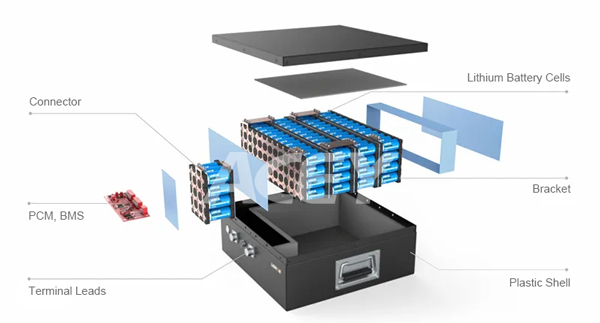
03 Lithium Battery Series-Parallel Combinations
For safety reasons, lithium batteries must be connected to an external protective plate to monitor each cell. Parallel operation is generally not recommended. If parallel operation is required, battery parameters (capacity, internal resistance, etc.) must be consistent. Furthermore, the parameters of the batteries used in series must also be consistent. Otherwise, the performance of the battery pack will be significantly worse than that of a single cell.


Lithium Battery Pairing Standards: Voltage Difference ≤ 10mV, Internal Resistance Difference ≤ 5mΩ, Capacity Difference ≤ 20mA
The purpose of lithium battery pairing is to ensure that the capacity, voltage, internal resistance, and performance of each battery in the battery pack are consistent. Inconsistencies will cause the various parameters of the lithium battery pack to deviate during use, resulting in voltage imbalance. Over time, this can lead to overcharge, overdischarge, and insufficient capacity, posing a risk of explosion or fire.
Lithium Battery Combination
2-String Lithium Battery Pack (7.4V Lithium Battery)
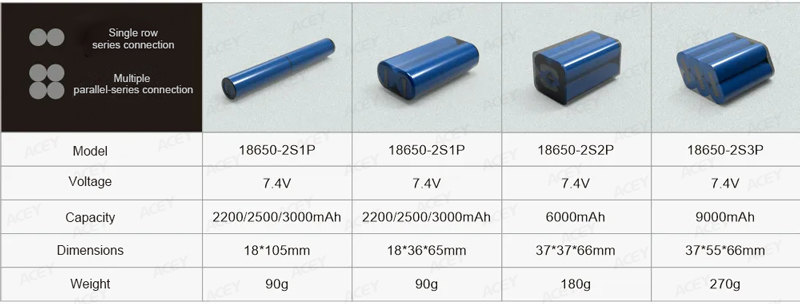
3-String Lithium Battery Pack (11.1V Lithium Battery)
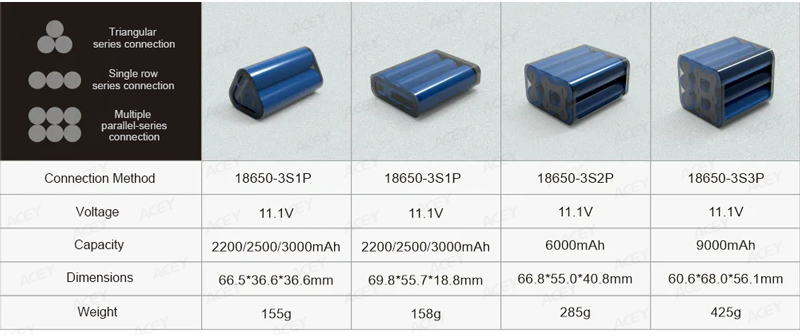
4-String Lithium Battery Pack (14.8V Lithium Battery)
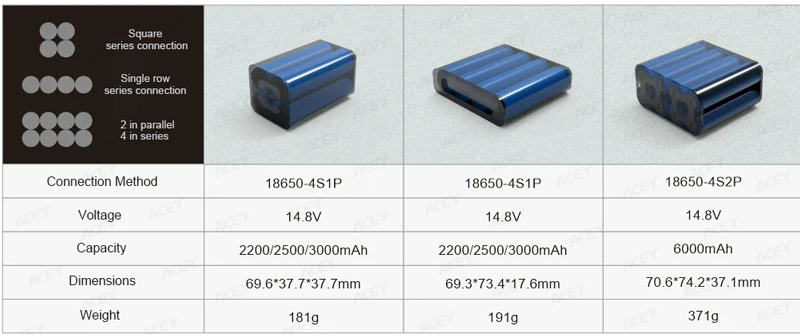
6-String Lithium Battery Pack (22.2V Lithium Battery)
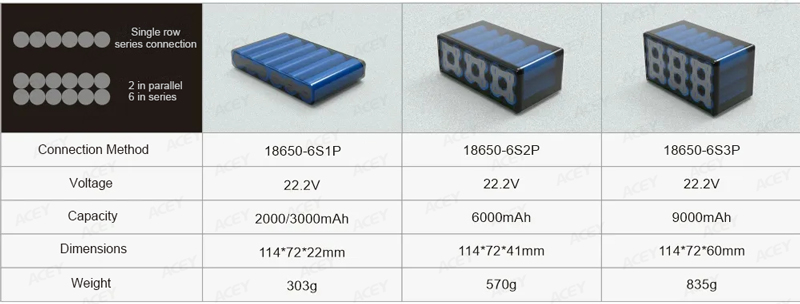
Lithium Battery Pack Cables/Terminals
The length of the lithium battery pack plug and lead can be customized to suit the customer's electrical equipment.
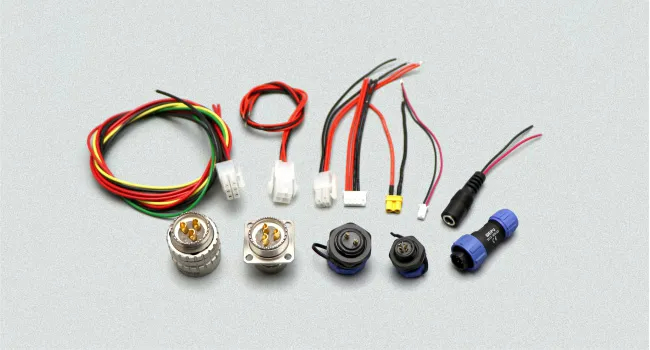
Lithium Battery Pack Series and Parallel Calculation
We all know that connecting lithium batteries in series increases voltage, while connecting them in parallel increases capacity. So, how do we calculate how many series and parallels a lithium battery pack has, and how many cells it comprises?
Before performing this calculation, we need to know the cell specifications used in the pack. Because different cells have different voltages and capacities, the number of series and parallels required to assemble a specific lithium battery pack varies. Common lithium battery cell types on the market include 3.7V lithium cobalt oxide, 3.6V ternary, 3.2V lithium iron phosphate, and 2.4V lithium titanate. Capacity varies depending on cell size, material, and manufacturer.
Taking a 48V 20Ah lithium battery pack as an example
-
Assuming the specifications of the single cell used are 18650 3.7V 2000mAh
-
Assuming the specifications of the single cell used are 18650 3.7V 2000mAh
-
Number of cells connected in parallel: 20Ah/2Ah = 10, i.e., 10 cells in parallel
-
The entire battery pack is 13 strings x 10 cells = 130 cells
Common series combinations of lithium battery packs
04 Lithium Battery Assembly Process
18650-3S6P/11.1V/15600mAh Lithium Battery Assembly Process
① Battery Capacity Grading
ACEY-BCT506R-512H lithium battery charge and discharge machine is designed for testing the capacity, voltage, current and charging & discharging performance of cylindrical lithium cells, such as 18650 21700 26650 32650 32700.
Capacity Difference ≤ 30mAh
After capacity sGrading, let stand for 48-72 hours before grouping
② Battery Insulation Paper Pasting
Apply quick-release paper and Mara tape for insulation.
ACEY-BS01 automatic insulation paper sticking machine is mainly used to stick a layer of barley paper on the positive or negative electrode of 18650/21700/26650/32650/32700 batteries to provide good insulation, wear resistance, waterproofing and other characteristics.
③ Battery Voltage and Internal Resistance Sorting
ACEY-AS11S lithium cell sorting machine is an efficient and high-precision device designed for rapid sorting of cylindrical lithium batteries. It uses an advanced internal resistance tester to accurately measure battery voltage and internal resistance. The equipment is compatible with various specifications of batteries (18650/21700/26650/32700/etc), with a sorting speed of up to 5000 PCS/hour, which greatly improves production efficiency and supports data export for easy quality traceability.
Voltage Difference ≤ 5mV
Internal Resistance Difference ≤ 5mΩ Eight cells with similar voltage and internal resistance are paired together.
④ Spot Welding of Battery Cells
Use molded nickel strips to eliminate cold solder joints, short circuits, low efficiency, and uneven current distribution.
ACEY-5000D manual spot welding machine is used to weld the positive and negative terminals of multiple batteries and materials such as nickel sheets together, ensuring stable current transmission during the charging and discharging process of the battery pack. It is widely used in welding many battery packs such as power batteries, electric tools, and electric bicycles, etc.
⑤ Welding the Protective Plate
Confirm that there are no leaking components on the circuit board, cold solder joints, or other defects.
⑥ Battery Pack Comprehensive Testing
ACEY-BIT Series battery comprehensive tester can make a quantitative and accurate measurement of some basic parameters of the battery. It can measure the open circuit voltage, internal resistance, charge, discharge, overcurrent protection, short circuit protection and other functions of the battery. It can easily detect bad batteries and increased production efficiency.
⑦ PVC Heat Shrink Film Wrapping
First, heat shrink the ends to position them.
Then heat shrink the center.
Ensure the PVC film is centered and free of white spots or leaks.
ACEY-5035C heat shrink film packaging machine is used in the assembly and packaging of battery packs, particularly for lithium-ion batteries and other types of rechargeable batteries. These machines are designed to securely wrap and seal battery packs using heat shrinkable film, providing protection, insulation, and a clean appearance to the battery packs.
⑧ Inkjet Batch Code Printing
The printing must be clear and legible.
ACEY-CP2 Inkjet batch coding machine is used for printing information such as batch numbers, expiry dates, manufacturing dates, barcodes, and other variable data onto products or packaging in manufacturing and packaging industries. This is essential for product traceability, quality control, and compliance with regulatory .
⑨ Battery Pack Aging
Determine the quality of the battery pack and ensure the stability, safety, and service life of the lithium battery pack during use.
ACEY-BA series battery aging machine is mainly used for battery charging and discharging and related battery characteristics testing. The test channels are completely independent and suitable for aging tests of ternary, lithium iron phosphate, lead-acid, nickel-metal hydride and nickel-cadmium batteries.
05 Precautions for Connecting Lithium Batteries in Series and Parallel
-
Do not use batteries of different brands together.
-
Do not use batteries of different voltages together.
-
Do not mix batteries of different capacities or old and new lithium batteries.
-
Batteries of different chemistries should not be mixed, such as nickel-metal hydride and lithium batteries.
-
When the battery charge is low, replace all batteries.
-
Use a lithium battery protection board with corresponding parameters.
-
Select batteries with consistent performance. Generally, lithium batteries used in series and parallel require cell pairing. Pairing criteria: voltage difference ≤ 10mV, internal resistance difference ≤ 5mΩ, and capacity difference ≤ 20mA.
① Lithium Batteries of Different Voltages in Series
Because lithium batteries have consistency issues, even when used in parallel and series within the same system (such as ternary or iron-lithium), it is important to select batteries with consistent voltage, internal resistance, and capacity. Using batteries of different voltage platforms and internal resistance in series can cause one battery to charge first and discharge last during each cycle. If a protection board is installed and does not malfunction, this will reduce the capacity of the entire group. Without a protection board, the battery will inevitably be overcharged or over-discharged, causing damage.

② Lithium Batteries of Different Capacities in Parallel
Mixing lithium batteries of different capacities or old and new batteries can cause leakage and zero voltage. This is because capacity differences during the charging process cause some batteries to be overcharged while others are undercharged. During discharge, high-capacity batteries may not be fully discharged, while low-capacity batteries may be over-discharged. This vicious cycle damages the batteries, causing leakage or low (zero) voltage.
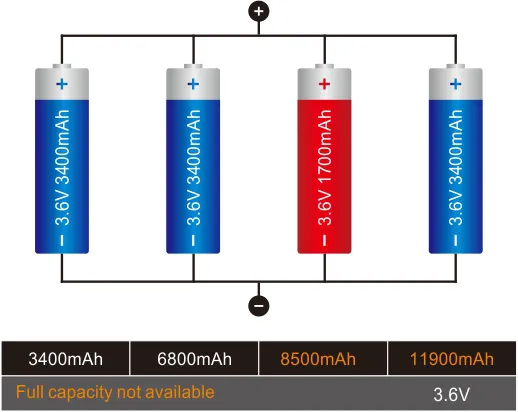
06 Should lithium batteries be connected in parallel or series first when assembling?
Lithium Battery Series-Parallel Topology
-
Typical connection methods for lithium battery packs include parallel first, then series, series first, then parallel, and mixed connection methods.
-
Lithium battery packs for pure electric buses typically use a parallel-first, then series connection method.
-
Lithium battery packs for grid energy storage often use a series-first, then parallel connection method.
Advantages of Parallel-First, Then Series-Second Connection for Lithium Batteries
-
A lithium battery cell failure automatically shuts down. Aside from a reduction in capacity, this does not affect the ability to operate in parallel.
-
If a lithium battery cell shorts in a parallel connection, the parallel circuit will experience very high currents, which is usually prevented by fuse protection technology.
Disadvantages of Connecting Lithium Batteries in Parallel First
-
Due to differences in internal resistance and uneven heat dissipation among lithium battery cells, the cycle life of a parallel-connected lithium battery pack can be affected.
Advantages of Connecting Lithium Batteries in Series First and Parallel Last
-
Connecting lithium battery cells in series first, based on their capacity, such as 1/3 of the total capacity, and then in parallel last, reduces the probability of failure in large-capacity lithium battery modules. Connecting in series first and then in parallel also significantly improves the consistency of lithium battery packs.
From the perspective of lithium battery pack connection reliability, the trend of voltage inconsistency, and its impact on performance, the parallel-first-then-series connection method is superior to the series-first-then-parallel connection method. The series-first-then-parallel lithium battery topology facilitates detection and management of each lithium battery cell in the system.
07 Charging Lithium Batteries in Series and Parallel
① Charging Lithium Batteries in Series
Currently, lithium battery packs are generally charged in series, primarily due to its simple structure, low cost, and ease of implementation. However, due to differences in capacity, internal resistance, attenuation characteristics, and self-discharge between individual lithium-ion batteries, when charging a lithium-ion battery pack in series, the smallest battery in the pack will be fully charged first. At this point, the other batteries will not be fully charged. If charging continues in series, the fully charged battery may be overcharged.
Overcharging a lithium-ion battery can severely damage its performance and may even cause an explosion, resulting in personal injury. Therefore, to prevent overcharging of individual lithium-ion batteries, lithium-ion battery packs are typically equipped with a battery management system (BMS). This system provides overcharge protection for each individual battery. During series charging, if the voltage of a single lithium-ion battery reaches the overcharge protection voltage, the BMS disconnects the entire series charging circuit and stops charging to prevent overcharging of that single battery, which would otherwise prevent the other batteries from fully charging.
②Charging Lithium Batteries in Parallel
When charging lithium-ion batteries in parallel, ensure that each battery is charged evenly. Failure to do so will affect the performance and lifespan of the entire battery pack. Common equalization charging techniques include: constant shunt resistor equalization charging, on-off shunt resistor equalization charging, average battery voltage equalization charging, switched capacitor equalization charging, buck converter equalization charging, and inductor equalization charging.
There are several things to note when charging lithium batteries in parallel:
-
Lithium batteries with or without protection boards cannot be charged in parallel. Batteries without protection boards are prone to overcharging and damage.
-
Batteries charged in parallel generally require the battery's built-in protection board to be removed and a single protection board used.
-
If batteries charged in parallel do not have a protection board, the charging voltage must be limited to 4.2V, and a 5V charger cannot be used.
When lithium batteries are connected in parallel, a charging protection chip provides charging protection. Lithium battery manufacturers fully consider the changing characteristics of parallel lithium batteries and design current and select cells based on these requirements when manufacturing parallel lithium batteries. Therefore, users should charge the batteries in accordance with the instructions for parallel lithium batteries to avoid potential damage to the batteries caused by improper charging.
③ Lithium Battery Charging Precautions
-
Lithium batteries must be charged using a dedicated charger. Otherwise, they may not reach full capacity, affecting their performance.
-
Lithium batteries do not need to be fully discharged before charging.
-
Do not leave the charger plugged in for extended periods. Remove the battery from the charger as soon as it is fully charged.
-
Remove the battery from any unused electrical appliances and drain it before storing.
-
Do not insert the battery with the polarity reversed, as this may cause the battery to swell or rupture.
-
Do not use nickel and lithium chargers interchangeably.








